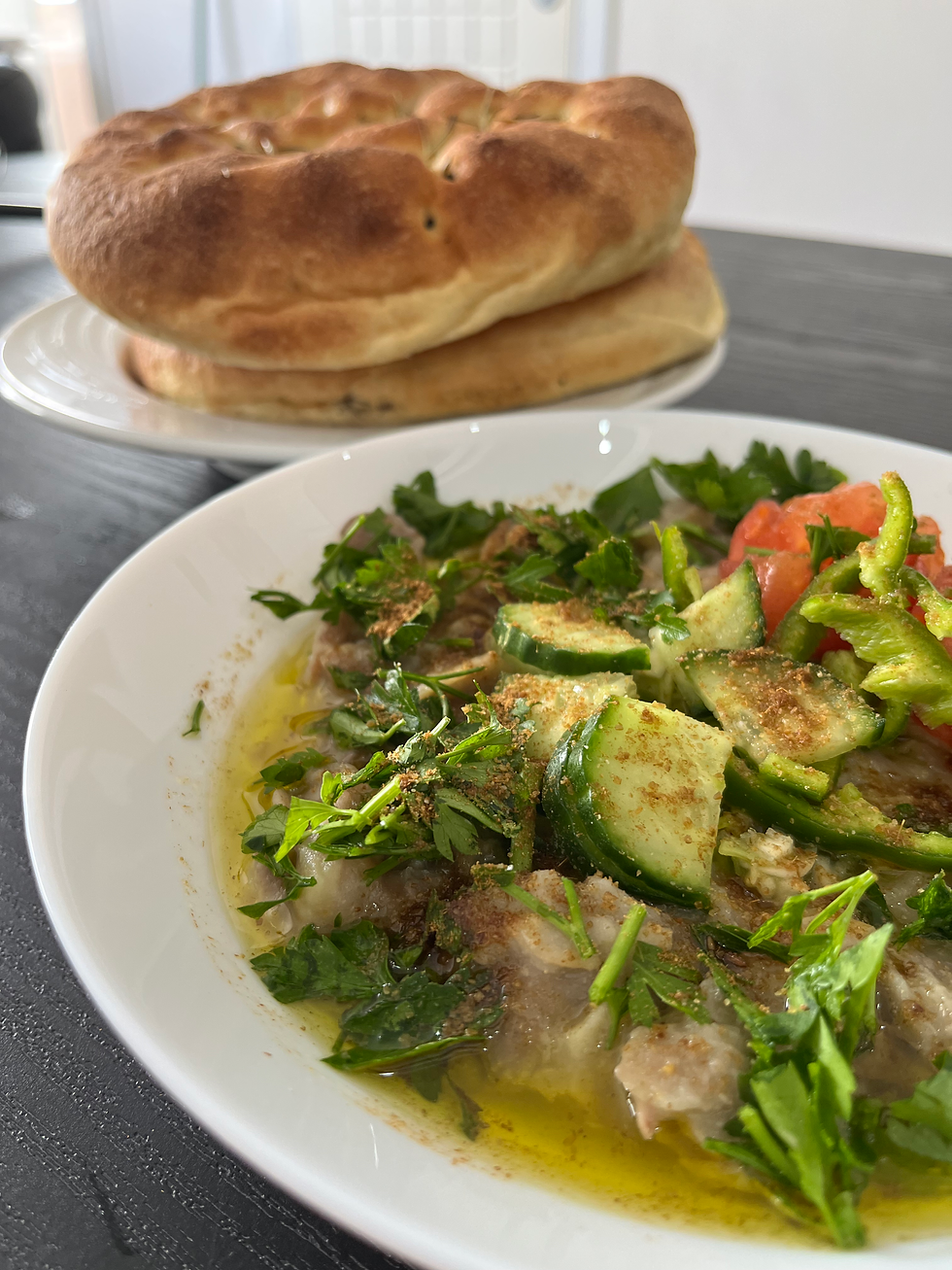A typical Egyptian breakfast made from Fava beans and lots of greens.
Click here for video recipe and story on Instagram

"Food is the doorway to the heart." - Naguib Mahfouz
Foul Medames, a cherished Egyptian dish, tells the tale of centuries-old flavors and cultural significance. Made from humble fava beans, this dish embodies the essence of Egyptian cuisine, a harmonious blend of history, tradition, and community. Often enjoyed for breakfast or as street food, Foul Medames captivates palates with its rich flavors and nourishing nature, uniting people over a shared love for its unique taste.
The history of Foul Medames weaves through the tapestry of Egypt's ancient past. Originating from the Nile Delta region, this dish's roots can be traced back to Pharaonic times, with evidence suggesting that fava beans were a dietary staple in the ancient Egyptian diet. Over millennia, Foul Medames evolved from a simple sustenance into a celebrated culinary treasure.
During the Islamic era, Foul Medames grew in popularity due to its affordability and nutritional value, aligning with Islamic principles of providing sustenance to those in need. Its accessibility made it a common dish, found on tables of both rich and poor, fostering a sense of unity and equality.
In contemporary Egypt, Foul Medames remains a beloved dish, adorning breakfast tables and street corners. It's an enduring link to the past, cherished for its authenticity and the warmth it brings to gatherings. With a resurgence of interest in traditional cuisine and a growing global appreciation for diverse flavors, Foul Medames finds itself in the spotlight, celebrated both locally and internationally.
In conclusion, Foul Medames stands as a tribute to Egypt's culinary legacy, a dish that reflects the nation's rich history, cultural values, and the enduring joy of shared meals. From ancient times to the present, Foul Medames continues to nourish both body and soul, fostering connections and reminding us of the profound role food plays in our lives.
Egyptian Foul Recipe
Prep time 30 minutes | Cook time 2 hours | Serves 6
Ingredients:
2 cups dried fava beans
4 cloves garlic, minced
1/4 cup olive oil
Juice of 2 lemons
Salt, to taste
Ground cumin, to taste
Chopped fresh parsley, for garnish
Chopped tomatoes, for garnish
Chopped green onions, for garnish
Hard-boiled eggs, for serving (optional)
Pita bread or Egyptian baladi bread, for serving
For the Garnish (choose any combination you prefer):
Chopped fresh tomatoes
Chopped green onions
Chopped parsley
Chopped radishes
Chopped cucumbers
Chopped pickles
Feta cheese or Egyptian "gibna domiati"
Instructions:
1. Soak the Fava Beans or use canned beans:
Rinse the dried fava beans and soak them in water overnight, or for at least 8 hours. The beans will expand, so make sure they are covered with water.
Many Egyptian households use pre-canned beans, because its easier and the texture is already established. I tried to do this with the dried beans and I chose the "large" favas, which was technically wrong. Shoot for smaller fava beans.
2. Cook the Fava Beans:
Drain and rinse the soaked fava beans. Place them in a large pot and cover them with water. Bring to a boil, then reduce the heat to a simmer. Cook the beans until they are tender, which usually takes about 1 to 1.5 hours. You can also use a pressure cooker to speed up the process. Make sure the beans are really cooked hard, so the texture is smooth.
3. Prepare the Beans:
Once the beans are cooked, drain them and return them to the pot. Mash the beans with a potato masher or the back of a spoon until they're partially mashed but still have some texture.
4. Season the Beans:
Add minced garlic, minced onion olive oil, lemon juice, salt, and ground cumin to the mashed beans. Mix well to combine the flavors.
5. Warm the Beans:
Place the pot with the seasoned beans over low heat and gently warm the mixture, stirring occasionally. Add a bit of water if the mixture becomes too thick.
If you want to use onion as a base, add onions to pan and cook until translucent. Add beans after.
6. Serve:
Spoon the warm Foul Medames onto individual serving plates or in shallow bowls.
Garnish the dish with chopped parsley, chopped tomatoes, chopped green onions, a big glug of good olive oil, tahina and any other garnishes you prefer.
7. Serving:
Foul Medames is typically served with pita bread or Egyptian baladi bread. It's common to tear off pieces of bread and use them to scoop up the beans.
Enjoy this classic Egyptian breakfast dish filled with flavors and textures that reflect the rich culinary heritage of Egypt!
If you do make this recipe, don’t forget to tag me on Instagram or Pinterest – seeing your creations always makes my day. Let's explore international cuisine together!
If you want to try to make more flavors of Middle East & North Africa region, check out the links my recipes below.
Middle East
Bahraini Harees - A humble mash of chicken and wheat
Emirati Luqaimat - Yeasted donuts in a sweet a fragrant syrup
Israeli Tahina - A delightful sesame sauce for any use.
Jewish Cholent - A hearty, beefy overnight stew.
Jordanian Kanafe - A show-stopping crispy cheese cake.
Lebanese Kibbeh - A crunchy, meaty stuffed bulgar dish.
Palestinian Maqluba - A towering one pot spiced rice and meat dish.
Syrian Hummus - A classic take on a perfect starter.
Turkish Imam Bayildi - A dish of roasted eggplant with a cumin infused tomato sauce.
North Africa
Algerian Mahjouba - A thin, semolina flatbread stuffed with tomatoes and onions
Egyptian Basboosa - A sweet semolina cake with simple syrup.
Egyptian Foul - A typical Egyptian breakfast made of stewed fava beans and good bread.
Libyan Bazin - A hearty stew served with mashed wheat.
Moroccan Couscous - A true North African classic featuring lamb and raisins.
Tunisian Ojja - A spicy and tomato-y egg dish.
Comments